Fix planned in 12.0.32, 15.2.13 and 16.3.3
If the security fix described in security bulletin SB2025-4 is enabled, networking packets can be falsely detected as malformed, causing a server station to force a disconnection. This issue leads to a situation where a client station may not be able to stay connected to a server station in a stable way.
Recommendation:
The issue does not manifest itself if the recent hardened connection mechanism is disabled. To disable this mechanism, the security alteration setting named ‘Networking.Allow security altering configuration options’ must be checked and the property ‘Allow stations with altered security’ on Nodes must be set to Yes.
Fix planned in 16.3.3
Since 16.3.0, BACnet COV re-subscriptions are not handled correctly, leading to a situation where BACnet variables are no longer monitored nor refreshed. Because the issue is related to re-subscription, it becomes obvious only after some time, once a re-subscription is necessary (typically 1 hour).
Recommendation:
A workaround exists. The issue does not exist in the legacy COV implementation. While it is no longer the default, it can be re-activated by adding the following key in the Etc\experimental.ini file:
[BACnetStackCov]
Enabled=1
Fix planned in 16.3.3
Since 16.3.0, a deadlock can occur when importing variables other than Internal. The issue manifests itself with a freeze during Application Architect generation or synchronization, while using a Smart Generator or the Xml Generic Import directly with the XmlImporter.exe command line. A forced exit of PcVue occurs after the 10-minute watchdog timeout.
Recommendation:
Product users who cannot wait for the fix should roll-back to 16.2.5.
We have a query execution defined to be repeated every 10 seconds and with a maximum received row count equal to 100:

Then in the query itself, we add conditions according our execution plan. We want to retrieve the last 100 values since the last retrieved value:
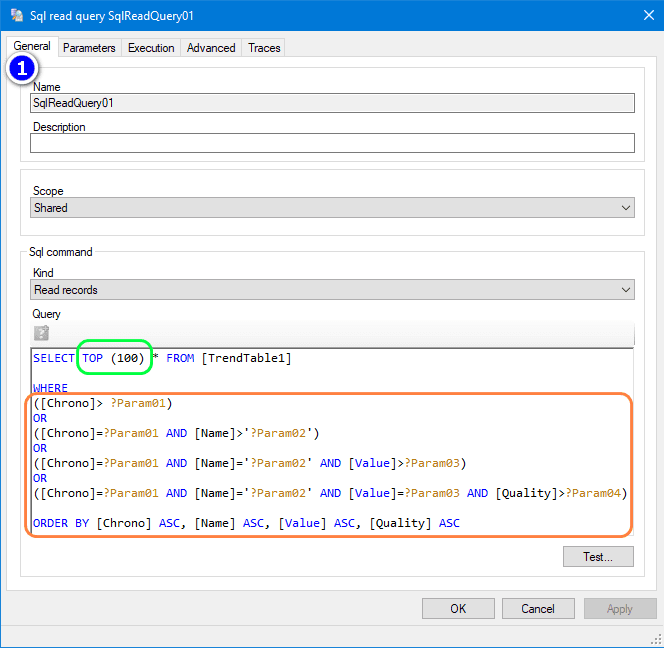
About the query:
SELECT TOP (100) * FROM [TrendTable1]
WHERE
([Chrono]> ?Param01)
OR
([Chrono]=?Param01 AND [Name]>’?Param02‘)
OR
([Chrono]=?Param01 AND [Name]=’?Param02‘ AND [Value]>?Param03)
OR
([Chrono]=?Param01 AND [Name]=’?Param02‘ AND [Value]=?Param03 AND [Quality]>?Param04)ORDER BY [Chrono] ASC, [Name] ASC, [Value] ASC, [Quality] ASC
TrendTable1: Name of the table
Chrono: Timestamp of the variable in the table
Name: Name of the variable in the database
Value: Value of the variable in the database
Quality: Quality of the variable in the database
Order: You need to sort (ASC) the result in order to retrieve the data chronologically
In the WHERE condition, we use dynamic parameters and we store them in PcVue Sql variables:
| Param01 | Param02 | Param03 | Param04 |
| Last Chrono | Last Name | Last Value | Last Quality |
| SQL.Query01.LastChrono | SQL.Query01.LastName | SQL.Query01.LastValue | SQL.Query01.LastQuality |
Creation of these variables:
1- Param01 corresponds to the chrono, so we need to create a text variable
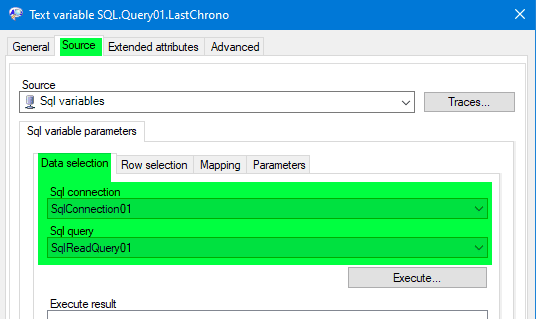
In Row selection: Select the last Row:

In Mapping: Select FieldValue(“Chrono”) for Value
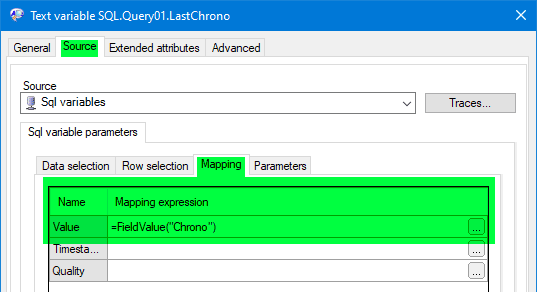
In parameters: Select =Value for ?Param01
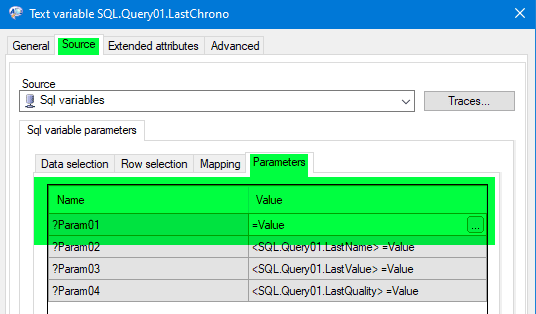
In advanced tab of the variable, Check Save

2- Param02 corresponds to the Name, we also need to create a text variable similar to the previous one.
-Map the variable:
– In Row selection: Select the last Row
– In Mapping: Select FieldValue(“Name”) for Value In parameters: Select =Value for ?Param02
– Advanced Tab : Check Save
3- Param03 corresponds to the Value, we need to create a register variable.
– Map the variable:
– In Row selection: Select the last Row
– In Mapping: Select FieldValue(“Value”) for Value In parameters: Select =Value for ?Param03
– Advanced Tab : Check Save
4- Param04 corresponds to the Quality, we also need to create a register variable.
– Map the variable:
– In Row selection: Select the last Row.
– In Mapping: Select FieldValue(“Quality”) for Value In parameters: Select =Value for Param04
– Advanced Tab : Check Save
The attached sample project shows an example of using SQL queries attached to SQL connections defined in PcVue. In particular, it shows a possibility to repeat the execution of these queries automatically under certain conditions.
First of all, you need to enter the correct login and password for the SQL connection declared in the general part of the Application Explorer:
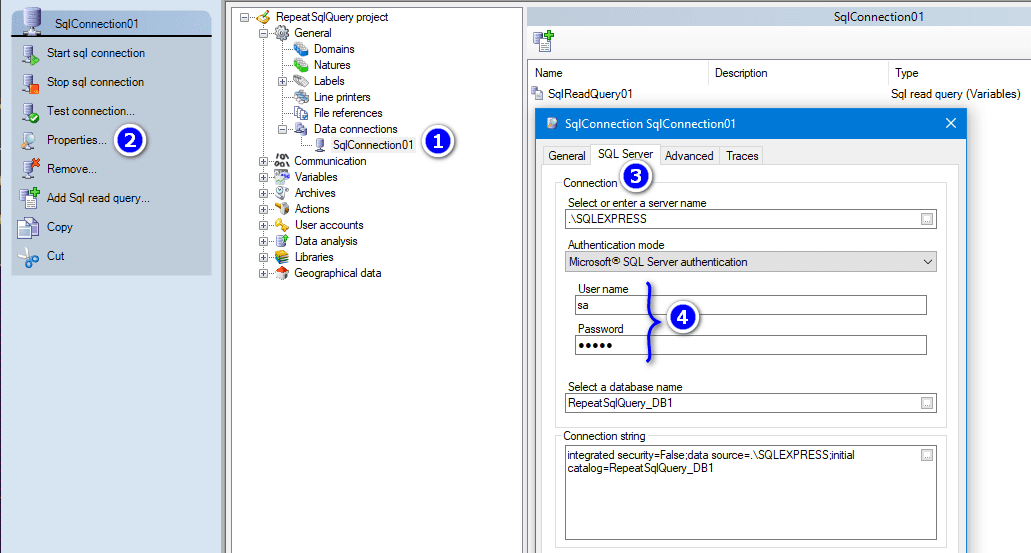
Check that the SV DbConnect service has been started:
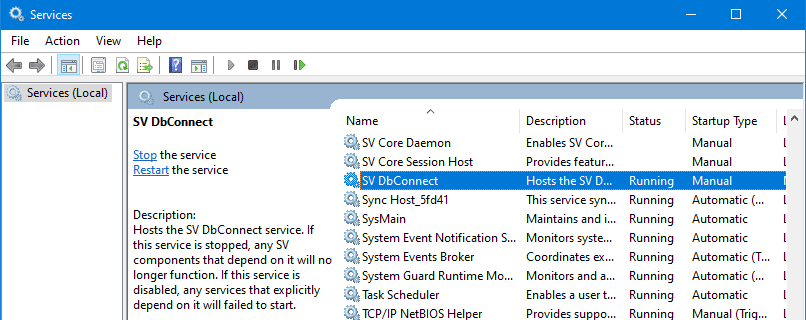
The query will be launched every 10 seconds. It will retrieve all the information from the TRENDTABLE1 table by packets of 100 rows, starting from the last information retrieved previously.
After the development of such a query, it is mandatory to run it at least once by manually entering the parameters. For instance if we want to get all data:
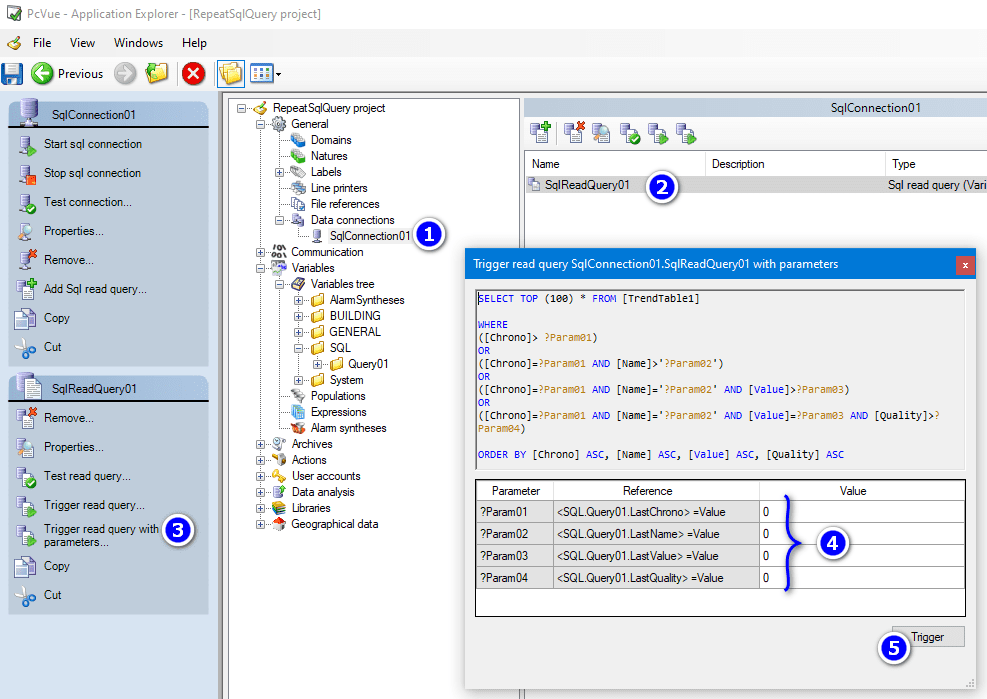
Warning: if the database size is important you should not use 0 for the field ?Param01 (Chrono) but an acceptable value instead.
Then, since we save the value of the internal variables that are used both to define the parameters of the query and to store their new value after each execution, the system works continuously.
If we look at the trend curve, we can see that the variable SQL.Query01.F1R1_TEMP only changes value every 10 seconds, at the rate of the SQL query. But in fact it changes value several times and all these changes are recorded with the timestamp coming from the TRENDTABLE1 table. So when we press the refresh button, we see a nice smooth ramp instead of stairs in real time.
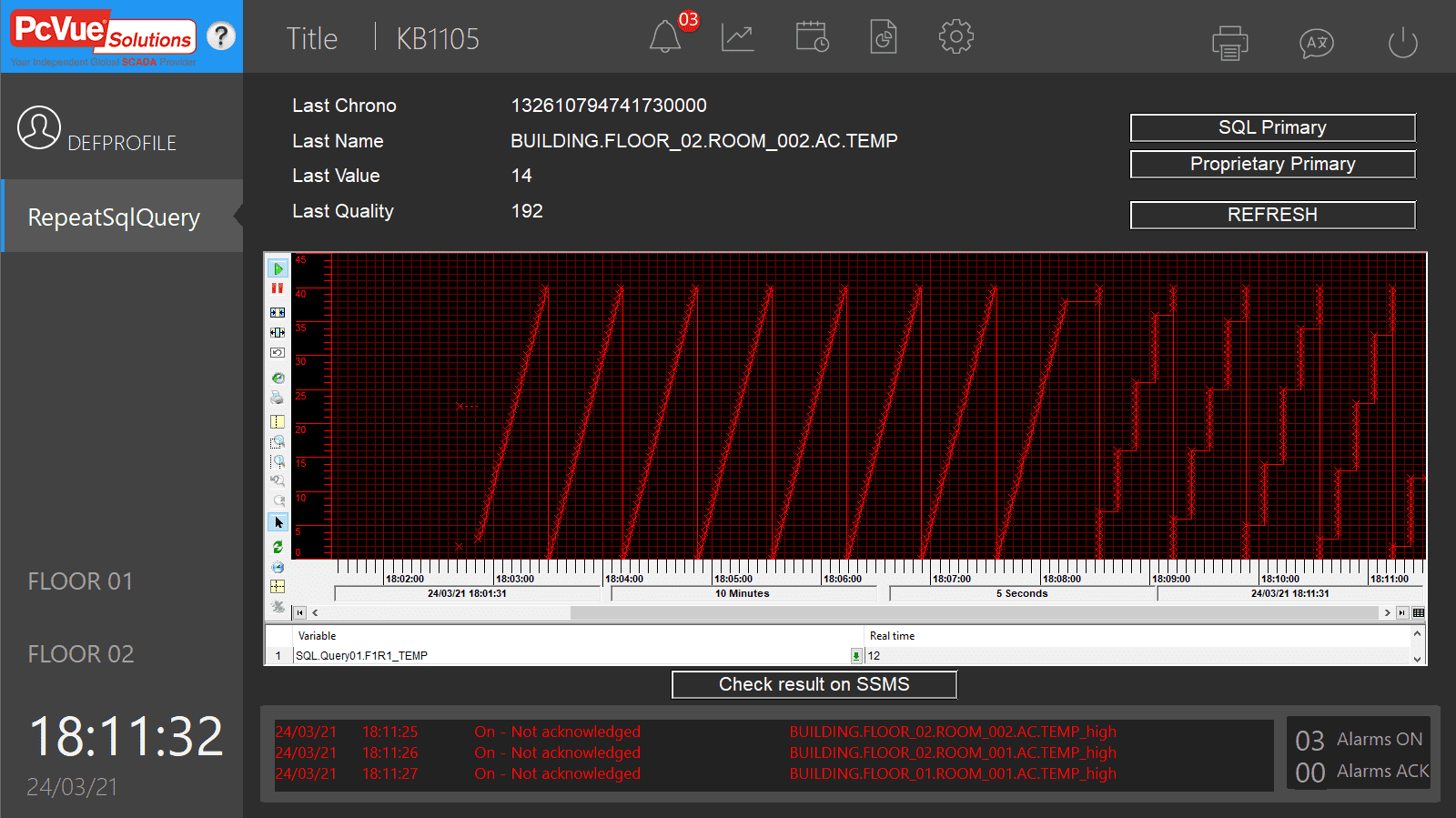
In order to record all the changes of values that can exist since the last execution of the query, we should not use a filtering period while we configure the trend for SQL.Query01.F1R1_TEMP variable, as explained in the Sql Variables and Data Archiving article.
Sample project:
The discovery of vulnerabilites in the PcVue client/server networking feature resulted in major fixes (see the security bulletin SB2025-4).
These fixes include the addition of security features to ensure the confidentiality and integrity of the messages exchanged between PcVue stations.
As this security feature is activated by default for new projects but also for migrated project (e.g. from version 16.2 to 16.3.1), users may experience communication issues between PcVue stations.
An updated station won’t be able to communicate with a not updated station. This situation will remain until all the stations have been migrated.
During this transient stage, the following warnings are logged and displayed in the event viewer :
2025/09/01,10:37:27.760,3,D,,3388,,11,Networking message version of station SERVER1 = 163000
2025/09/01,10:37:27.760,3,W,,3712,,11, Networking, the version ‘163000’ of the remote station ‘SERVER1’ is not compatible due to security constraints
2025/09/01,10:37:27.760,3,W,,3072,,11,Client->server connection CLIENT10C -> SERVER10S is aborted
…
2025/09/01,10:37:46.228,3,I,,3070,,11,Server->client connection CLIENT10S -> SERVER10C is OK
2025/09/01,10:37:46.230,3,W,,3716,,11,Networking, connection CLIENT10S -> SERVER10C is not secure, the remote node ‘DATASERVER10’ must not alter the security or the local node must allow it
2025/09/01,10:37:46.230,3,W,,3142,,11,Server->client connection CLIENT10S -> SERVER10C is rejected
The Allow stations with altered security option has been implemented to disable the security feature if the migration is to be carried out in several stages and take some time.
This option can be found in the Networking settings :
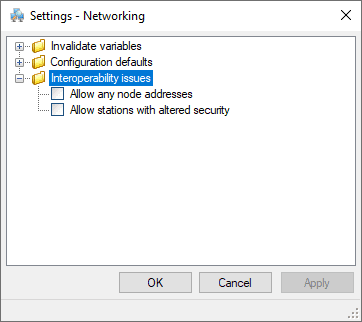
or in the advanced part of a station node:
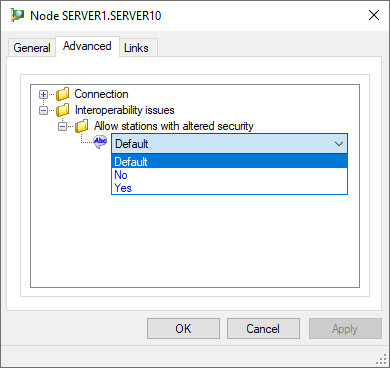
A whitelist filter has also been implemented to control which IP addresses are authorised to connect to the station.
This withelist is defined by the Networking configuration. This control can be disabled by selecting the Allow any node adresses option.
When selecting the allow stations with altered security option, keep in mind that the stations will be exposed to the discovered vulnerabilities.
When using the Smart Genrator BACnet, sometimes, after selecting the EDE file, the following dialog appears :
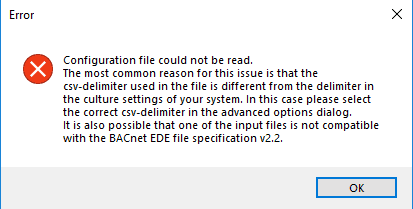
The first reason explained is about the csv-delimiter used in the EDE file.
In this case, you just have to change this parameter in the advanced options: 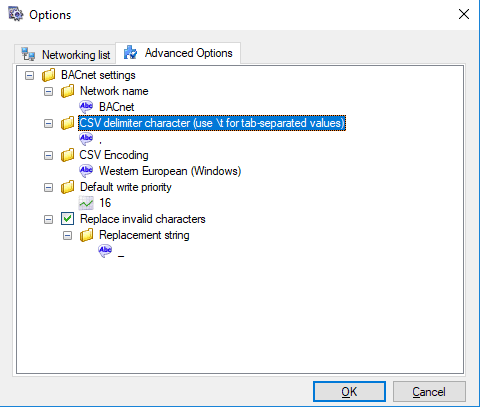
Also, the problem could come from the contained of the EDE file :
- According to KB 1101, if the device-object type is not present in the EDE file, PcVue won’t be able to create a device and associate objects to it.
- As an EDE file is mainly provided by a manufacturer software, the format and structure of column could be different as expected, for example :
- The column title “Supports Cov” have to be written without dash between “Supports” and “Cov”.
- Extra columns could be presents but are not expected such as “schedule-type”,”schedule-state-text-reference” or “schedule-unit-code”. These columns are not defined in the EDE specification.
- Some mistakes (a title column is missing or not well written)
N.B : The v2.2 (released in 2007) and v2.3 (released in 2017) layout are supported.
Attached to this article, you will find a template of an EDE file provided by the BIG-E.U which can be perfectly imported in PcVue.
You can us it and compare it to your EDE file.
PcVue provides the ability to access data from the running project via Web Services technology.
All the provided functions and services are grouped together in a development kit, called Web Services Toolkit.
Web Services Toolkit allows third-party applications to exchange data with the supervisor. It is a server API (Application Programming Interface) that provides following accesses:
- Authentication/session management
- Realtime data access
- Real time alarm access
- Historical data access: logged events and trends
- Graphical data: mimics and symbols
Web Services Toolkit is available for several technologies:
- SOAP/XML since SV version 8.00
- REST since SV version 12.0
Current article provides the developer manual for both technologies:
| PcVue SOAP/XML API | WST_DeveloperManual.pdf |
| PcVue RESTful API | WST_REST DeveloperManual_1_0.pdf |
PostgreSQL is “the world’s most advanced open-source relational database”. It’s made by PostgreSQL Global Development Group.
Unfortunately, PostgreSQL like some open source projects such as Maria DB does not offer a ready to use ADO.NET provider.
Once the binaries are obtained it is possible to install a third party provider with the tool : “ProviderInstaller.exe”.
To be detected by PcVue, each ADO.NET provider must be installed in the Global Assembly Cache (GAC) of the .NET framework and referenced in the machine.config file. The tool “ProviderInstaller.exe” is there to facilitate this task.
— How to install PostgreSQL ADO.NET Provider —
1. Download Attachment “Npgsql 8.0.7 install.zip”
2. Extract “Npgsql 8.0.7 install.zip” to “Npgsql 8.0.7 install”
3. Open CMD prompt as Administrator
4. Change directory to be in “Npgsql 8.0.7 install” directory
cd “C:\Users\Dev\Desktop\Npgsql 8.0.7 install”
5. Run following command:
ProviderInstaller.exe /install

6. Restart your computer and then PcVue
— How to configure a PostgreSQL connection in PcVue —
1. At PcVue side, with Application Explorer, navigate to General > Data connections
2. Add a new SQL Connection as below
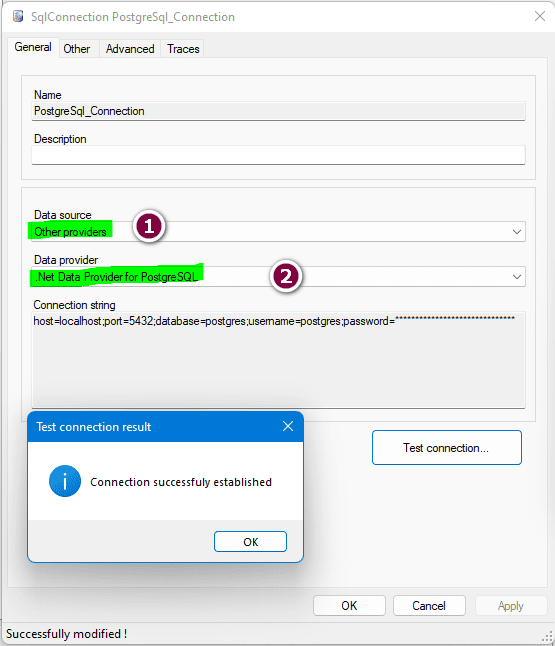

The connection string should be as below :
Host=localhost;Port=5432;Database=postgres;Username=postgres;Password=******************************
Fill these informations in according to your database connection informations.
Like that you can get a successful connect to your postgres database server by clicking on test connection button.
— Some usuals Sql queries —
.Create a table
CREATE TABLE MyTable (col1 INT)

. Insert a value
INSERT INTO MyTable (col1) VALUES (1)
. Display table content
SELECT * FROM public.mytable
| Attached file | Description |
| Npgsql 8.0.7 install.zip | Npgsql 8.0.7 install |
By default, the exported file does not display sample timestamp with milliseconds, even though export sampling is done in milliseconds.
To display milliseconds, you generally need to change the date format of the language configured in Data Export.
The default time format is: HH :mm :ss (even if nothing is selected).
You therefore need to modify the time format of the language configured for export as follows:
HH :mm :ss .fff
In this example, the language is set to configuration 1:

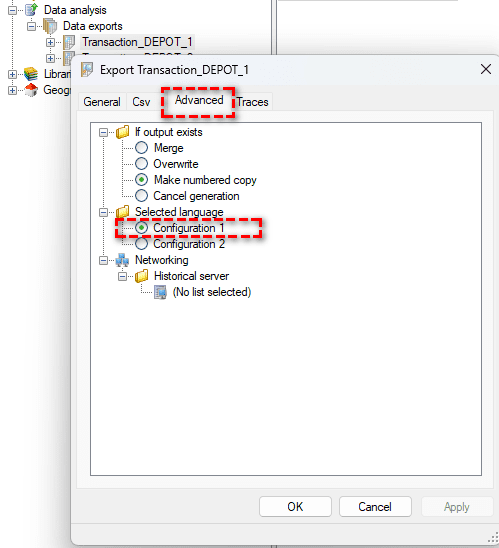
Useful links:
https://www.pcvue.com/ProductHelp/PcVue/fr/Content/AE/Project/Languages_settings.php
https://www.pcvue.com/ProductHelp/PcVue/fr/Content/AE/DataExport/Advanced.php
|
Applies to:
PcVue 16 onwards |
||||||||
|
Summary:
This article contains attached files at the end. This provider has been developed for the IoT offering to position PcVue as a serious solution for aggregating IoT data.The other providers launched at the same time were Live Object, Sigfox and The Things Network. Interact with devices managed by Netmore Platform. |
||||||||
|
Status:
This provider has the status: Release candidate |
||||||||
|
Details:
Download the latest version of the provider proposed in the table at the end of this article and unzip it to execute the msi file. Follow the instruction given in the ADO.Net Providers installation procedure article to install this provider. To declare a connection into PcVue, goto General -> Data connections -> Add a SQL connection and select the Data source Built-in providers, then you can choose .NET Framework Data Provider for Netmore Data provider: 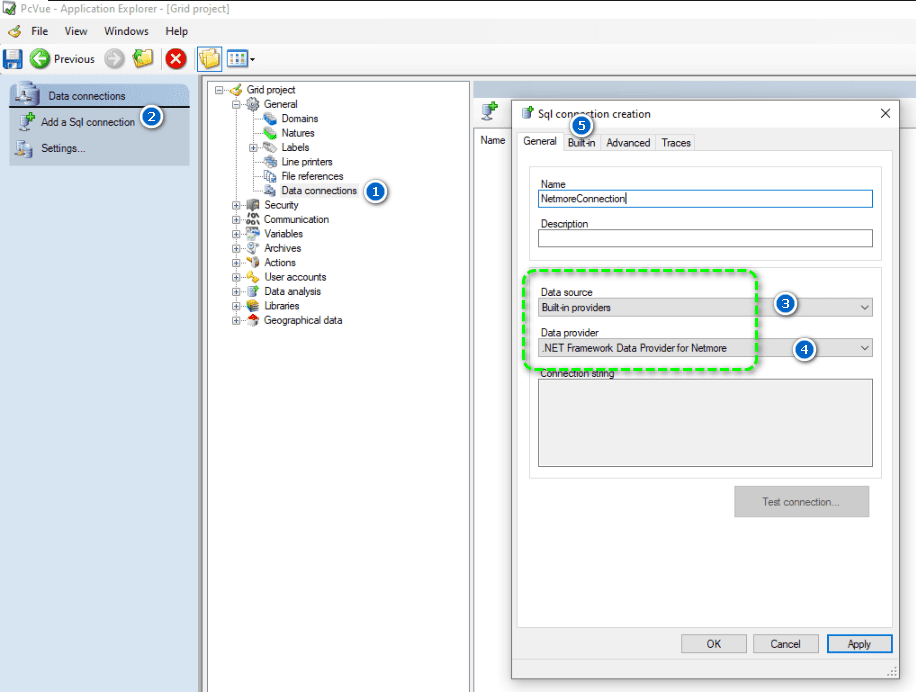 Netmore Provider declaration part 1
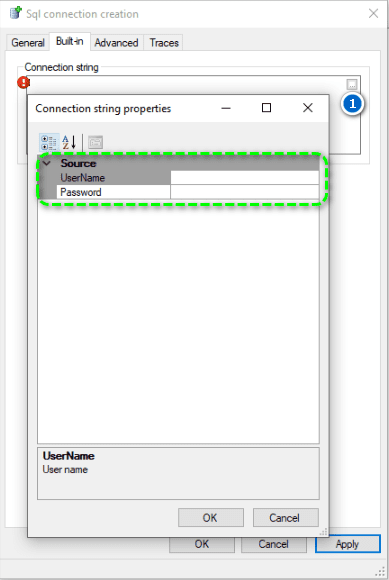 Netmore Provider declaration part 2 Few sample queries: SELECT * FROM [get_net/sensors] MAXDEPTH(0) SELECT * FROM [get_ net/sensors/70B3D5E820002169/values] MAXDEPTH(0) Files attached consist in the:
|
||||||||
|
|
Issue
PcVue may crash when opening a 3D mimic if a required DLL is missing at initialization.
Cause
The absence of the DLL at mimic startup causes a critical error, as the file is required for certain 3D functionalities.
Solution
To avoid this issue, the FSTAT instruction can be used in a PcVue program to check for the presence of the DLL during initialization (in the initialization program).
Steps to follow:
- Create a verification function in a PcVue program:
- Use the FSTAT instruction to test for the presence of the DLL.
- FSTAT returns 0 if the file is missing, and 1 if it is present (as it provides the file size and last modification date).
- Control a bit variable:
- If the DLL is present → the variable is set to 1.
- If the DLL is missing → the variable is set to 0.

sub verif()
DIM res as integer;
DIM bufh as LONG; ‘buffer handle
CONST ALLOC=22; ’22 is the minimum required
Dim str_path as str;
Dim name as str;
Dim chemin as str;
CONST ALLOC=22; ’22 is the minimum required
str_path = GetApplicationDir();’for the access path
chemin = ADDSTRING(str_path,”\\D3DX9_43.dll”);’ the complete access path
bufh=ALLOC_BUFFER(ALLOC);
res=0;
res= FSTAT(chemin,bufh);
print(res);
print(bufh);
if (res=!0) then
@DLL_present =1;
end if
FREE_BUFFER(bufh); ‘free buffer
end sub
- Configure the Link/open animation of the mimic:
- In the Interlock condition field, insert the status variable.
- Define the access condition (e.g., allow access only if the variable = 1).

| File | Description |
| ReadMe.pdf | The readme file in English |
This document contains information about version 16:
- What’s new in 16.0 – An overview of the main new features in version 16 Initial Release (16.0.0)
- What’s new in 16.1 – An overview of the main new features in the 16.1 Feature Release (16.1.0)
- What’s new in 16.2 – An overview of the main new features in the 16.2 Feature Release (16.2.0)
- What’s new in 16.3 – An overview of the main new features in the 16.3 Feature Release (16.3.0)
- System requirements
- Installation
What’s new in 16.0
HMI
- Web browser control – A new built-in graphic control to display web content and Pdf files in a mimic.
Installation and deployment
- Support for Microsoft® Windows 11 and Windows Server 2022.
What’s new in 16.1
- Feature enhancements and fixes.
What’s new in 16.2
- Support for the visibility animations on more graphic elements, including symbols and most graphic controls.
- Feature enhancements and fixes.
What’s new in 16.3
- The Comment property is now available as a runtime tooltip for all animations.
- Multiline tooltips that automatically combine the Comment property values of all animations linked to a graphic element into a single tooltip at runtime.
- Feature enhancements and fixes.
System requirements
Operating systems
Only operating systems from the Microsoft® families of Windows 10, Windows 11, Windows Server 2016, Windows Server 2019 and Windows Server 2022 are supported.
We recommend you use Windows Client versions for operator stations and Windows Server versions for server stations.
Supported and operational
- Windows 10 version 1607 or later – Professional and Enterprise Editions
- Windows 11 – Professional and Enterprise Editions
- Windows Server 2016 – Essentials, Standard and Datacenter Editions
- Windows Server 2019 – Essentials, Standard and Datacenter Editions
- Windows Server 2022 – Essentials, Standard and Datacenter Editions
All operational versions of Windows Server shall be installed with the ‘Desktop Experience’ option.
Operational but may have limitations in use
Please contact the technical support before using:
- Windows 10 IoT Enterprise LTSC 2016 or later, Windows 11 IoT Enterprise, Windows Server IoT 2019, Windows Server IoT 2022, Windows Server for Embedded Systems and all other embedded systems
- Any operating system hosted in a system virtual machine such as Microsoft® Hyper-V and VMWare® virtualization products
NOT supported
- All other versions of Windows 10 and Windows 11 – In particular Windows 10 version 1507 (RTM) and 1511 (Nov 2015 update) are not supported
- Windows 10 IoT Core
- Windows Server installation in Nano Server or Server Core mode
For all operational versions of Windows 10 and Windows 11, only the x64 processor architecture is supported.
The software requires .NET Framework 4.8 and cannot run on an operating system if .NET Framework 4.8 is not preinstalled or cannot be installed separately.
For all platforms, we recommend that you apply any critical updates available from the Windows Update web site.
For any other Microsoft® operating system, please contact the Technical Support.
Recommended minimum PC configuration
- Processor – x64-compatible AMD or Intel CPU (or equivalent) – 1.4 GHz dual core minimum.
- System Memory – 4 GB of RAM.
- Available hard disk space – At least 10 GB.
- Graphics – 1024×768 display for Windows Server platforms. In addition for Windows Client platforms, support for DirectX 9 graphics device with WDDM driver.
- Network Interface Card – At least 1.
- Drives – A DVD drive, as appropriate, is required for installation from disc.
The above figures represent the minimum requirements. For advice on specific applications, please contact the Technical Support.
Installation
For information about the Microsoft® Windows user privileges required to install and run the product, see the following topic in the online help: Operating system related considerations.
See the Installation help for more information and help about prerequisites and the installation process itself.
Microsoft and Microsoft Windows are trademarks of Microsoft Corporation.
Last edit: May 16th, 2025


